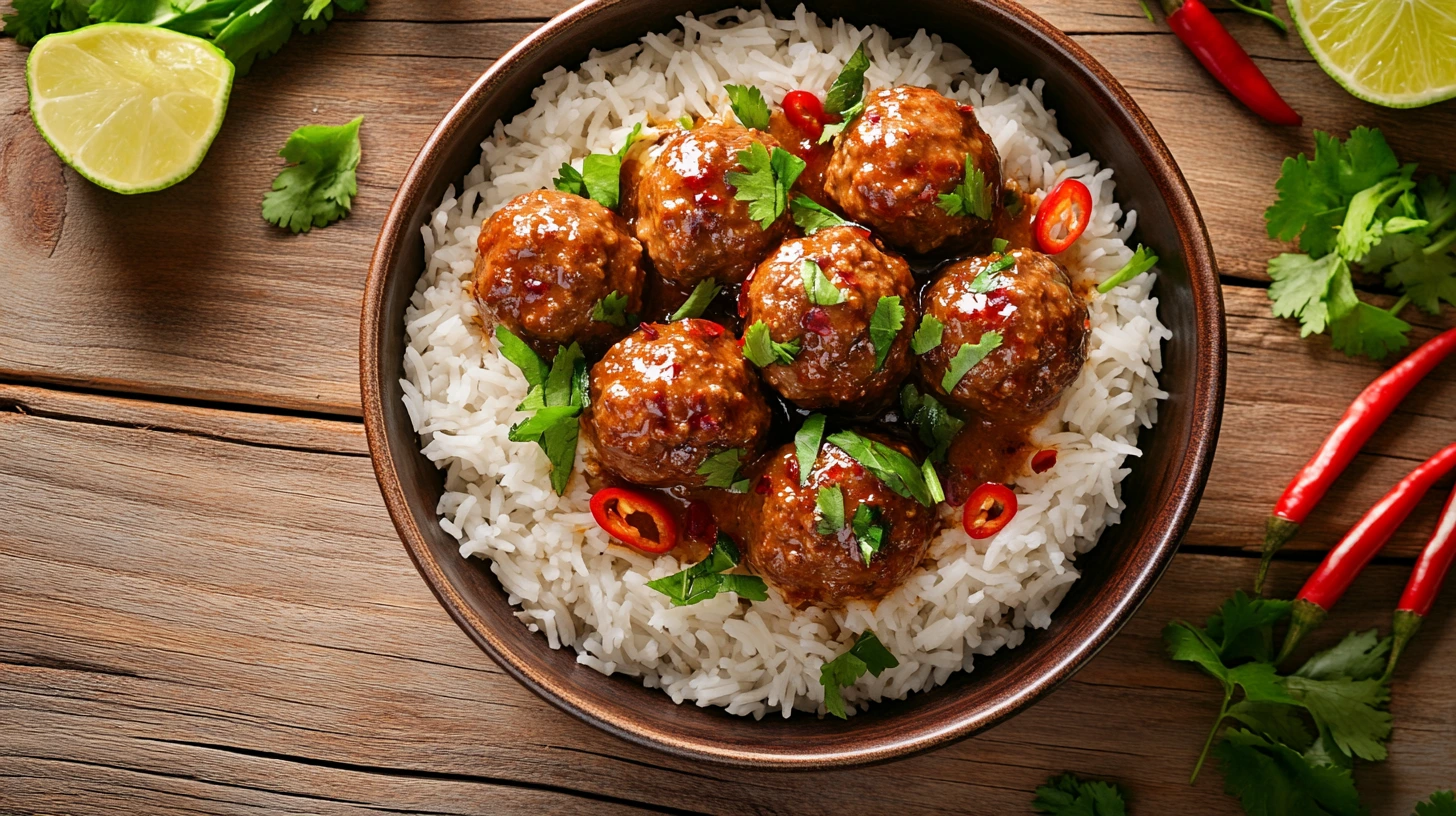Red Curry Meatballs are the perfect fusion of bold Thai flavors and hearty comfort food. These tender, juicy meatballs are simmered in a creamy red curry sauce made with coconut milk, aromatic herbs, and just the right amount of spice. Whether you’re looking to spice up your dinner routine or impress guests with something a little different, this dish delivers both flavor and simplicity.
Blending the richness of ground meat with the vibrant heat of Thai red curry paste, red curry meatballs are a crowd-pleasing dish that’s quick enough for weeknights yet special enough for entertaining. Serve them over jasmine rice, noodles, or even cauliflower rice for a satisfying meal that hits every note—savory, spicy, creamy, and just a little sweet.
In this recipe guide, you’ll learn how to make the ultimate red curry meatballs from scratch, including tips for customizing the spice level, choosing the best ingredients, and pairing them with sides for a complete meal. Let’s dive into this delicious twist on a Thai classic!
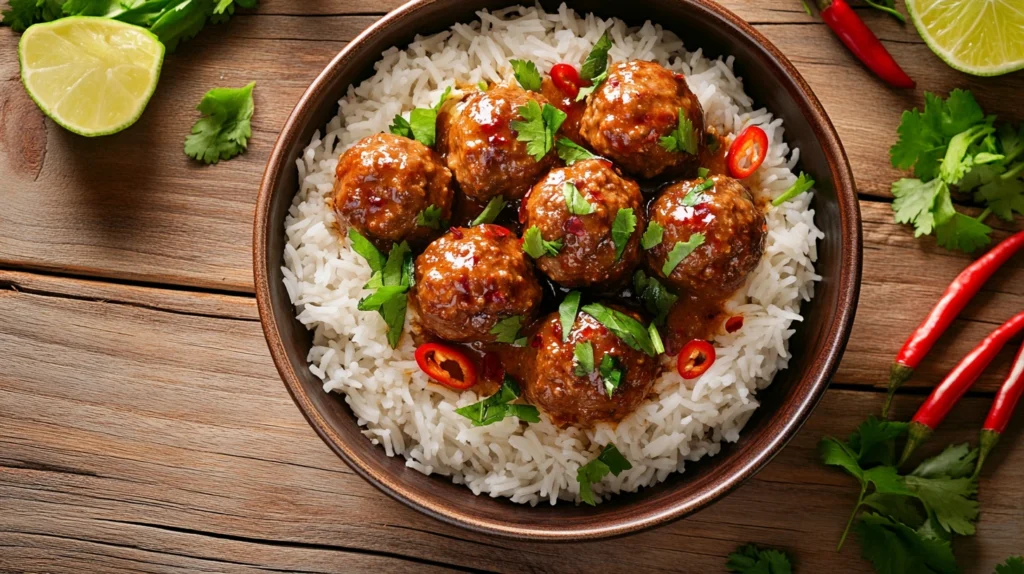
What Are Red Curry Meatballs?
Red curry meatballs are a flavorful fusion dish that combines the rich, aromatic spices of Thai red curry with the hearty, satisfying bite of classic meatballs. This dish isn’t just a trendy twist—it’s a celebration of how two culinary worlds can collide to create something truly unforgettable.
Whether you’re familiar with Thai food or just dipping your toe into the world of curry, red curry meatballs are the perfect entry point. They balance the heat of red chili peppers with creamy coconut milk and fragrant herbs, giving the meatballs a luxurious sauce that soaks into every bite. It’s comfort food with a serious flavor upgrade.
Craving more globally-inspired fusion? You’ll also enjoy the Korean Ground Beef Bowl — a bold, savory twist on traditional beef and rice dishes.
Thai Red Curry Meets Western Meatballs
The origin of red curry lies in Thailand, where it’s known as “Gaeng Phed.” It’s traditionally made with red chilies, garlic, lemongrass, kaffir lime, galangal, and shrimp paste, all ground together into a vibrant, spicy paste. This paste is then cooked with coconut milk and protein like chicken, shrimp, or tofu.
Now, add in Western-style meatballs — typically made with ground meat, breadcrumbs, and spices — and you’ve got something special. Red curry meatballs are the perfect example of culinary fusion: the richness of curry blends beautifully with the savoriness of meatballs, creating a dish that feels familiar yet exotic.
Key Differences from Traditional Meatballs
Traditional meatballs, like Italian or Swedish versions, are usually simmered in tomato-based or creamy brown sauces. They often lean heavily on garlic, cheese, and herbs like oregano or parsley.
Red curry meatballs, however, take a turn toward Southeast Asia. They feature fresh aromatics like ginger and lemongrass, use curry paste instead of tomato sauce, and are simmered in a silky coconut-based broth. Plus, they usually pack more heat, making them ideal for spice lovers.
They also tend to be lighter in texture due to ingredients like fish sauce or soy sauce instead of salt, and fresh herbs like Thai basil or cilantro add a pop of brightness that cuts through the richness.
Ingredients Overview
Cooking red curry meatballs doesn’t require a culinary degree—just the right ingredients and a little know-how. Below is a breakdown of everything you need for both the meatballs and the luscious curry sauce.
Choosing the Right Meat
The foundation of any great meatball is the protein. You can use a variety of meats depending on your taste and dietary needs:
- Ground Pork: Traditional and juicy, it absorbs the curry flavors wonderfully.
- Ground Chicken or Turkey: Lighter in fat but still flavorful.
- Ground Beef: Rich and hearty, though it can overpower the curry if too lean.
- Plant-Based Meat Alternatives: Perfect for vegans or vegetarians. Brands like Beyond Meat or tofu-lentil blends work well.
The key is to strike a balance between fat and lean meat. Use ground meat with an 80/20 lean-to-fat ratio for the best, juiciest flavor.
Thai Red Curry Paste Explained
This is the heart and soul of the dish. Red curry paste provides the signature color, aroma, and kick. It’s made from a blend of:
- Dried red chilies
- Garlic
- Galangal or ginger
- Lemongrass
- Kaffir lime zest
- Shallots
- Shrimp paste (optional for vegetarians)
You can buy red curry paste at most grocery stores or Asian markets. Popular brands include Maesri, Thai Kitchen, and Aroy-D. For full control of flavor and heat, consider making your own at home.
Supporting Ingredients
Aside from the meat and curry paste, here’s what else you’ll need:
- Coconut Milk: Choose full-fat for a rich, creamy sauce. Light coconut milk works, but won’t be as luxurious.
- Using fresh garlic and ginger adds the most vibrant and rich flavor to the soup.
- Shallots or Onion: Adds depth and sweetness.
- Fish Sauce or Soy Sauce: For saltiness and umami.
- Breadcrumbs and Egg: Help bind the meatballs.
- Lime Juice or Kaffir Lime Leaves: For brightness and citrus notes.
- Fresh Herbs: Thai basil, cilantro, or scallions for garnish.
Optional ingredients:
- Brown sugar or palm sugar to balance the heat.
- Chili flakes or fresh chili if you want to turn up the fire.
Optional: Add-ins like lime juice or even veggies, just like those in this Layered Mexican Salad for a fresh, colorful contrast.
Step-by-Step Red Curry Meatballs Recipe
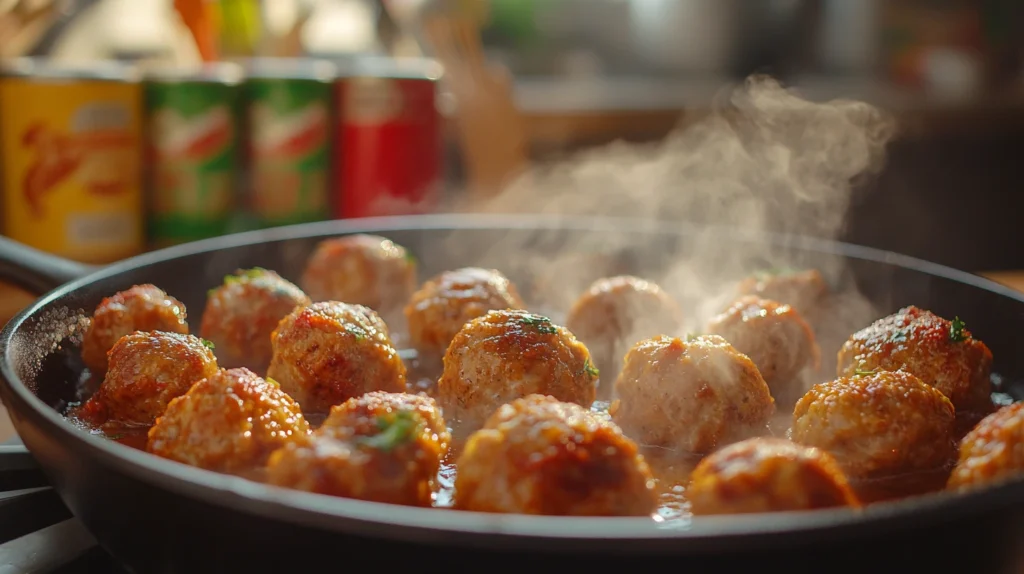
Now that you’ve gathered your ingredients and understand what makes red curry meatballs so special, it’s time to roll up your sleeves and get cooking. This section will guide you through each step, from mixing your meatball blend to finishing them in that creamy red curry sauce. Whether you’re a kitchen newbie or a seasoned home cook, this recipe is easy to follow and sure to impress.
Prepping the Meatballs
The foundation of perfect red curry meatballs starts with a well-seasoned, balanced meat mixture. Here’s how to get it just right:
Ingredients for Meatballs:
- 1 lb ground pork or meat of choice
- 1/4 cup breadcrumbs (panko or plain)
- 1 egg
- 2 cloves garlic, finely minced
- 1 tablespoon ginger, grated
- 1 teaspoon fish sauce or soy sauce
- 1 tablespoon finely chopped cilantro or Thai basil
- Pinch of salt and pepper
Steps:
- Combine all ingredients in a large bowl.
- Mix gently with your hands or a spatula. Don’t overwork the mixture, or the meatballs may become tough.
- Form into balls roughly 1 to 1.5 inches in diameter. You should get about 16–20 meatballs.
- Optional tip: Chill the meatballs in the fridge for 10–15 minutes. This helps them hold their shape during cooking.
Cooking Methods
There are a few different ways you can cook your meatballs before adding them to the curry sauce. Each method offers slightly different textures and results.
1. Pan-Frying (Recommended):
- Heat 2 tablespoons of oil in a non-stick skillet over medium heat.
- Add meatballs and cook, turning occasionally, until browned on all sides (about 8–10 minutes).
- Remove and set aside.
2. Baking:
- Preheat oven to 400°F (200°C).
- Arrange meatballs on a parchment-lined baking sheet.
- Bake for 15–18 minutes or until golden and cooked through.
3. Air-Frying:
- Preheat air fryer to 375°F (190°C).
- Spray meatballs lightly with oil.
- Cook for 12–14 minutes, shaking halfway through.
Each method results in slightly different textures. Pan-frying gives a lovely golden crust, while baking and air-frying are healthier options and more hands-off.
Simmering in Curry Sauce
Once your meatballs are cooked, it’s time to let them soak up all the flavor in a rich, creamy red curry sauce.
Ingredients for Curry Sauce:
- 2 tablespoons red curry paste
- 1 can (13.5 oz) full-fat coconut milk
- 1 tablespoon fish sauce or soy sauce
- 1 teaspoon brown sugar
- Juice of 1/2 lime
- Optional: 1 teaspoon chili flakes (for extra heat)
- Fresh herbs and sliced red chilies (for garnish)
Steps:
- In the same skillet you used for pan-frying (or a clean pan), add a splash of oil and sauté the red curry paste over medium heat for 1–2 minutes until fragrant.
- Pour in coconut milk slowly while stirring to dissolve the paste evenly.
- Add fish sauce, lime juice, and sugar to balance the heat and acidity.
- Simmer gently for 3–4 minutes, allowing the flavors to meld.
- Add cooked meatballs into the sauce and simmer for another 5–7 minutes until heated through and infused with curry flavor.
- Garnish with chopped cilantro, Thai basil, or sliced chili. A squeeze of fresh lime right before serving brings everything to life.
You’ve just created a dish that’s bursting with flavor, easy to pull off, and guaranteed to satisfy.
Serving Suggestions
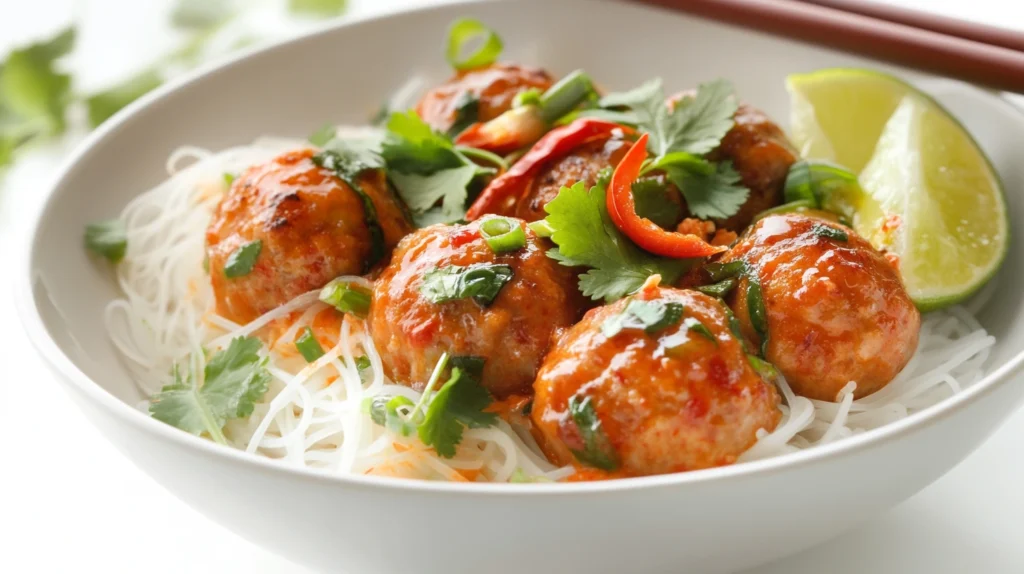
And if you’re in the mood for a lighter meal earlier in the day, you might enjoy Strawberries and Cream Oatmeal — it’s the perfect breakfast before a flavor-packed dinner like this.
Once your red curry meatballs are bubbling in that flavorful sauce, it’s time to think about presentation and sides. The beauty of this dish lies in its versatility—you can go traditional, modern, or even fusion. Whether you’re serving it for a casual family dinner or a special gathering, there are plenty of creative ways to enjoy this bold, spicy comfort food.
Best Side Dishes
Pairing your red curry meatballs with the right side dish can enhance their flavor and balance out the heat. Here are some popular and satisfying options:
1. Jasmine or Basmati Rice
Fluffy, fragrant rice is the classic side. It soaks up the curry sauce beautifully and acts as a neutral base to balance the spice. Basmati adds a slight nuttiness, while jasmine rice keeps it traditionally Thai.
2. Coconut Rice
For a little extra indulgence, cook rice with coconut milk and a pinch of sugar. It complements the curry’s richness and adds a subtle sweetness.
3. Rice Noodles
Soft, slippery noodles make a fun twist and hold the sauce well. Try serving your meatballs over wide rice noodles or vermicelli for a Thai noodle bowl vibe.
4. Cauliflower Rice or Zoodles (Zucchini Noodles)
Going low-carb? These veggie alternatives are light and fresh, making them great for a healthier version of the dish.
5. Roti or Naan Bread
It’s not traditional Thai, but warm, soft bread is perfect for scooping up curry sauce. It’s especially great if you’re serving this as a shared appetizer or small plates meal.
Garnishing and Presentation
Never underestimate the power of a good garnish! A well-chosen topping can add color, crunch, and brightness to balance the creamy, spicy sauce.
Here are a few go-to garnishes:
- Chopped fresh cilantro or Thai basil – Adds an herbaceous, fresh touch.
- Sliced red chili or chili flakes – For spice lovers who want extra heat.
- Lime wedges – A squeeze of lime wakes up the entire dish.
- Toasted sesame seeds or crushed peanuts – A little crunch and a nutty undertone.
- Scallions or green onions – Mild onion flavor and a pop of green.
When it comes to plating, try serving your meatballs in a shallow bowl with rice or noodles at the base, topped with the meatballs and curry sauce, and then a sprinkle of garnishes. It’s restaurant-quality at home!
Customization and Variations
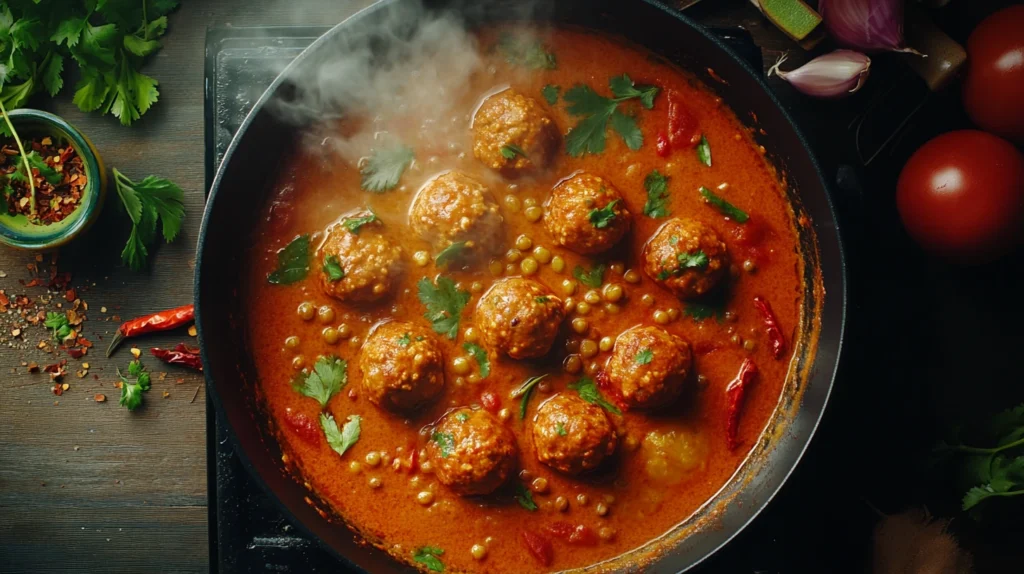
One of the best things about red curry meatballs is how adaptable they are. Whether you’re cooking for dietary restrictions, trying to scale down the spice, or just want to mix things up, there are plenty of ways to make this dish your own.
Vegan or Vegetarian Versions
If you’re skipping meat, you don’t have to skip flavor. These options will give you just as much satisfaction:
1. Tofu Meatballs – Use firm tofu, crumbled and mixed with breadcrumbs, soy sauce, garlic, and herbs. Bake or pan-fry just like regular meatballs.
2. Lentil or Chickpea Meatballs – Cooked red lentils or mashed chickpeas are great protein-packed bases. They soak up the curry beautifully.
3. Plant-Based Meats – Beyond Meat or similar brands make easy swaps with a texture close to ground meat.
Be sure to use a vegetarian curry paste (some contain shrimp paste), and swap fish sauce for soy sauce or tamari to keep it 100% plant-based.
Spiciness Adjustments
Not everyone can handle the heat—and that’s okay! Here’s how to control the spice level:
- Milder Curry Paste: Look for “mild” red curry pastes or cut the amount in half.
- Add Coconut Milk: Extra coconut milk helps mellow the heat and creates more sauce.
- Skip the Chili Garnish: Skip sliced chili or chili flakes in the sauce or as garnish.
- Add Sugar or Lime: A teaspoon of brown sugar or a squeeze of lime balances spicy flavors.
Conversely, if you want to turn up the heat, add fresh red chili, a spoonful of sambal oelek, or extra curry paste.
Global Fusion Ideas
Why stop at Thai? Use this base recipe as a canvas for international flavor combinations:
- Italian-Thai Fusion: Add sun-dried tomatoes and serve over spaghetti noodles with a coconut-tomato curry sauce.
- Indian Twist: Use garam masala and curry leaves in the meatball mix, and finish with a coconut-lentil curry base.
- Mediterranean Flare: Mix oregano and feta into the meatballs, and replace curry paste with harissa for a North African vibe.
These twists keep the cooking exciting and let you experiment with new ideas while still staying close to the essence of red curry meatballs.
Storage and Meal Prep Tips
Whether you’re making red curry meatballs for a quick weeknight meal or batch-cooking for the week ahead, proper storage is key to keeping the flavors fresh and the texture just right. This dish is actually one of those rare meals that tastes even better the next day as the flavors continue to develop.
Refrigeration and Freezing
Refrigeration: Red curry meatballs store well in the fridge for up to 4 days.
- Storage Tip: Let the dish cool completely before transferring it to an airtight container. Store the meatballs and sauce together or separately—whichever is easier for your reheating method.
- Serving suggestion: As a time-saving tip, prep a double batch of the curry sauce and store half in a jar for a quick meal later in the week.
Freezing: Yes, you can absolutely freeze red curry meatballs—and they reheat beautifully.
- Freeze Cooked Meatballs Separately: For best results, freeze the meatballs after cooking but before adding them to the curry sauce. Flash-freeze them on a baking sheet, then store in a freezer-safe bag or container for up to 3 months.
- Freeze the Curry Sauce Alone or Together: Coconut milk-based sauces freeze well. If you’re freezing the meatballs in the sauce, use a sturdy container and leave a bit of space for expansion.
To use from frozen:
- Thaw in the fridge overnight, then reheat gently on the stove or in the microwave.
Reheating Without Losing Flavor
When reheating red curry meatballs, the key is to preserve the creamy texture of the coconut milk and avoid drying out the meat.
Stovetop Reheating (Best Method):
- Add meatballs and sauce to a skillet over medium-low heat.
- Stir occasionally, and add a splash of water or coconut milk if the sauce is too thick.
- Heat until warmed through, about 5–7 minutes.
Microwave Reheating:
- Use a microwave-safe bowl with a loose cover or vented lid.
- Heat in 1-minute intervals, stirring in between, until evenly hot.
- Add a bit of water or coconut milk to keep things saucy.
Oven Reheating:
- Preheat oven to 350°F (175°C).
- Place meatballs and sauce in an oven-safe dish, cover with foil, and heat for 15–20 minutes.
No matter how you reheat them, your red curry meatballs will come back to life with all the same vibrant flavors and aromas as when you first made them.
Health and Nutrition Facts
While red curry meatballs feel indulgent, they can be a surprisingly balanced and nourishing meal—especially when made with quality ingredients and thoughtful sides.
Here’s a general breakdown of the nutrition profile per serving (based on a recipe using ground pork, coconut milk, and white rice, serves 4):
| Nutrient | Amount (Approx.) |
|---|---|
| Calories | 450–550 kcal |
| Protein | 20–25 g |
| Carbohydrates | 20–30 g |
| Fats | 30–35 g |
| Saturated Fats | 15–18 g |
| Fiber | 2–4 g |
| Sodium | 600–800 mg |
Benefits of Key Ingredients:
- Coconut Milk: Rich in healthy fats (MCTs) that provide long-lasting energy. It’s also dairy-free and ideal for lactose-intolerant eaters.
- Red Curry Paste Spices: Ginger, garlic, chili, and lemongrass have anti-inflammatory and antioxidant properties.
- Ground Meat: Provides essential protein, iron, and vitamin B12. Leaner meats or plant-based options can lower fat and calories.
- Herbs and Aromatics: Thai basil, cilantro, and lime juice support digestion and immune health.
- Optional Add-ins: Add shredded carrots, spinach, or bell peppers to the curry sauce for extra fiber and nutrients without altering the taste too much.
Make It Healthier:
- Use lean protein like ground turkey or chicken.
- Use brown rice or quinoa instead of white rice to boost the fiber content.
- Reduce sodium by using low-sodium soy sauce or making your own curry paste.
- Use light coconut milk or mix half light with half full-fat to reduce calories.
With a few mindful tweaks, red curry meatballs can become a staple in a health-conscious meal plan while still delivering big on flavor.
Frequently Asked Questions
How to tell if red curry paste has gone bad?
Red curry paste can last for months in the fridge if stored properly, but it can eventually spoil. Here’s how to spot the signs:
- Smell: If the paste has a sour, off, or fermented odor (beyond its natural funk), it’s likely spoiled.
- Color Change: Red curry paste naturally darkens over time, but if it turns unusually brown or gray, that’s a red flag.
- Texture or Mold: Any mold growth or separation of liquids with foul odor means it should be discarded.
- Taste Test: If you’re unsure, taste a tiny bit. If it tastes bitter, stale, or dull, it’s time for a fresh jar.
Once opened, curry paste should be stored in an airtight container in the refrigerator and used within 2–3 months for best quality.
What meat is best with red Thai curry?
The beauty of red Thai curry is its flexibility—you can pair it with almost any protein. However, when it comes to red curry meatballs, here are the best choices:
- Ground Pork: Juicy and flavorful, it holds the bold curry well.
- Ground Chicken: Light and lean, great if you want a lower-fat option.
- Ground Beef: Rich and hearty but can be a little overpowering if too fatty.
- Ground Turkey: A healthy alternative that’s mild enough to let the curry shine.
For best results, choose a mix with some fat (80/20 ratio) so the meatballs stay moist and flavorful.
Does red curry paste need to be refrigerated after opening?
Yes, red curry paste should be refrigerated after opening to maintain its freshness and prevent spoilage. Here are some quick storage tips:
- Store it in its original jar with the lid tightly sealed.
- Wipe down the rim to avoid crusting or contamination.
- Place it in the coldest part of the fridge (not the door).
- Consider transferring to an airtight glass container for longer shelf life.
Refrigerated curry paste usually lasts 2–3 months after opening. You can also freeze portions in an ice cube tray for longer storage—perfect for small-batch cooking.
How long should meatballs sit before cooking?
Letting meatballs rest for 10–15 minutes in the fridge before cooking helps them firm up and hold their shape better during cooking, especially if you’re pan-frying or baking them.
This short resting time also allows the flavors to meld and helps the breadcrumbs absorb moisture more evenly. If you’re prepping ahead, you can shape the meatballs and refrigerate them for up to 24 hours before cooking.
Pro Tip: Lightly oil your hands when forming meatballs to prevent sticking and ensure a smooth, uniform shape.
Conclusion
Red Curry Meatballs offer an irresistible blend of spicy, creamy, and savory flavors that transform a simple meatball dish into something truly memorable. With every bite, you get the comforting richness of tender meatballs balanced perfectly by the zing of Thai red curry and the silkiness of coconut milk.
Whether you’re serving them at a casual dinner or meal-prepping for the week, red curry meatballs are versatile, easy to make, and endlessly customizable. Add fresh herbs, squeeze a bit of lime, or toss in seasonal veggies to make it your own.
Now that you have the step-by-step guide, helpful tips, and serving ideas, it’s time to bring some global flavor to your table. One pan, one pot of rice, and these flavorful meatballs—that’s all you need for a truly satisfying meal. Enjoy!
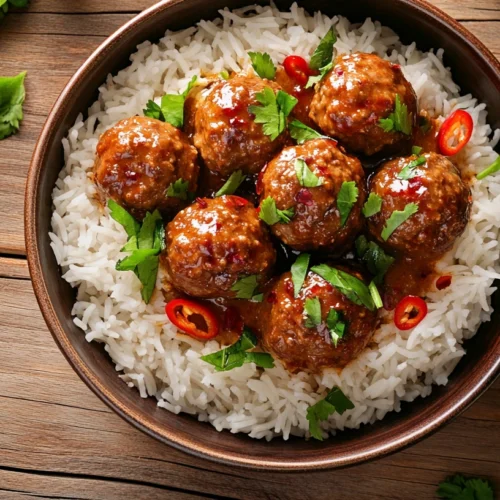
Red Curry Meatballs – Thai Fusion Comfort Food with Bold Flavor
Equipment
- Large mixing bowl
- Skillet or non-stick frying pan
- Measuring cups and spoons
- Wooden spoon or spatula
- Baking sheet (if baking)
- Blender or food processor (optional for homemade curry paste)
Ingredients
- For the Meatballs:
- 1 lb 450g ground pork (or chicken, turkey, beef, or plant-based)
- 1/4 cup breadcrumbs use gluten-free if needed
- 1 egg
- 2 cloves garlic finely minced
- 1 tbsp grated ginger
- 1 tbsp fish sauce or soy sauce
- 1 tbsp chopped cilantro or Thai basil
- 1/4 tsp salt
- 1/4 tsp black pepper
- Oil for cooking
- For the Red Curry Sauce:
- 2 tbsp Thai red curry paste
- 1 can 13.5 oz / 400ml full-fat coconut milk
- 1 tbsp fish sauce or soy sauce
- 1 tsp brown sugar
- Juice of 1/2 lime
- 1 tsp chili flakes optional for extra heat
- Fresh cilantro Thai basil, or scallions for garnish
- Lime wedges for serving
Instructions
- Make the Meatballs:
- In a large bowl, combine ground meat, breadcrumbs, egg, garlic, ginger, fish/soy sauce, cilantro, salt, and pepper.
- Mix gently until just combined—avoid overmixing.
- Roll into 1–1.5 inch balls. Chill in the fridge for 10–15 minutes.
- Cook the Meatballs:
- Pan-Fry: Heat oil in a skillet over medium heat. Cook meatballs until golden brown on all sides (8–10 minutes). Set aside.
- Bake (Alternative): Bake at 400°F (200°C) for 15–18 minutes.
- Make the Curry Sauce:
- In the same skillet, sauté red curry paste in a bit of oil for 1–2 minutes until fragrant.
- Stir in coconut milk, fish sauce, sugar, and lime juice. Simmer for 3–4 minutes.
- Add cooked meatballs and simmer for another 5–7 minutes until coated and heated through.
- Serve:
- Serve over steamed jasmine rice, noodles, or cauliflower rice. Garnish with fresh herbs, chili, and lime wedges.

